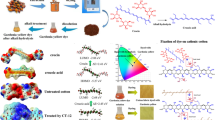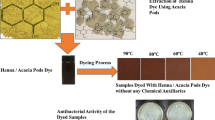Abstract
In the current pandemic scenario, sustainable green products particularly antiviral, antioxidant, and antibacterial in nature are gaining worldwide fame in almost every walk of life. Cassia obovata (C. obovata) has been valorized as a source of yellow natural dye for nylon dyeing. For the isolation of dye extracts and for surface tuning, nylon fabrics were treated with microwave rays up to 10 min. For getting new shades with good to excellent fastness characteristics, sustainable bio-mordants in comparison with chemical mordants have been used at 60 °C, 70 °C, and 80°C. It has been found that for getting effective colorant yield, acidic extract should be exposed to MW ray treatment up to 6 min, and for getting improved fastness rating, bio-mordants have given excellent color characteristics. Statistical optimization of dyeing variable shows that application of 40 mL of C. obovata acidic extract of RE of 6 pH containing 3 g/100 mL of salt when employed at 55 °C for 45 min has given excellent results onto irradiated nylon fabric (RNF). It is inferred that Cassia obovata has an excellent potential for coloration of surface-modified fabrics, where the application of low amount of bio-mordants under statistical optimized conditions has made process more ecological, economical, and sustainable.
Graphical abstract











Similar content being viewed by others
Data availability
As this is part of M.Phil studies, so whole data is present in M.Phil thesis.
References
Adeel S, Rehamn FU, Hussaan M, Amin N, Majeed A, Pervaiz M, Rehman HU (2021a) Microwave assisted green isolation of laccaic acid from lac insect (Kerria lacca) for wool dyeing. Prog Color Color Coat 14(4):293–299
Adeel S, Rehman FU, Zia KM, Azeem M, Kiran S, Zuber M, Qayyum MA (2021b) Microwave-supported green dyeing of mordanted wool fabric with Arjun bark extracts. J Nat Fibers 18:135–150
Adeel S, Kiran S, Yousaf MS, Habib N, Hassan A, Hassan M (2021c) Eco-friendly isolation of tannin based natural colorant from coconut coir (Cocos nucifera) for dyeing of bio-mordanted wool fabric. Global Nest J 23(1):65–72
Alebeid OK, Pei L, Elhassan A, Zhou W, Wang J (2020) Cleaner dyeing and antibacterial activity of wool fabric using Henna dye modified with Acacia nilotica pods. Clean Technol Environ Policy 22(10):2223–2230
Ansari TN, Iqbal S (2021) Antibacterial efficiency of naturally occurring dyes and mordants. Eur Pub Med Cent. https://doi.org/10.21203/rs.3.rs-266420/v1
Arifeen WU, Rehman FU, Adeel S, Zuber M, Ahmad MN, Ahmad T (2021) Environmental friendly extraction of walnut bark-based juglone natural colorant for dyeing studies of wool fabric. Environ Sci Pollut Res. https://doi.org/10.1007/s11356-021-14277-8
Atav R, Buğdaycı B, Yakın I (2021) Laccase-catalyzed simultaneous dye synthesis and cotton dyeing by using plant extracts as dye precursor. J Text Inst 1-9.https://www.tandfonline.com/doi/abs/10.1080/00405000.2021.1896159
Baaka N, Haddar W, Ben Ticha M, Amorim MTP, M'Henni MF (2017) Sustainability issues of ultrasonic wool dyeing with grape pomace colourant. Nat Prod Res 31(14):1655–1662
Baseri S(2021) Natural bio-source materials for green dyeing of cellulosic yarns. J Nat Fibers. 1-12. https://www.tandfonline.com/doi/abs/10.1080/1544047820201870626
Buyukakinci YB, Guzel ET, Karadag R (2021) Organic cotton fabric dyed with dyer's oak and barberry dye by microwave irradiation and conventional methods. Ind Textila 72(1):30–38
Chakraborty L, Pandit P, Maulik SR (2020) Acacia auriculiformis-a natural dye used for simultaneous coloration and functional finishing on textiles. J Clean Prod 245:118921
Elnagar K, Abou Elmaaty T, Raouf S(2014) Dyeing of polyester and polyamide synthetic fabrics with natural dyes using ecofriendly technique. J TextInst
Elshemy NS, Haggag K (2019) New trend in textile coloration using microwave irradiation. J Text Color Polym Sci 16(1):33–48
Gashti PM, Stir M, Bourquin M, Hulliger J (2013) Mineralization of calcium phosphate crystals in starch template inducing a brushite kidney stone biomimetic composite. Cryst Growth Des 13(5):2166–2173
Gözütok Z, Bahtiyari MI 2020 Improving the light fastness of the wool dyed with pomegranate peels. J Nat Fibers 1-11 https://www.tandfonline.com/doi/abs/10.1080/1544047820201767753
Haule LV, Nambela L, Mgani Q (2020) A review on source, chemistry, green synthesis and application of textile colorants. J Clean Prod 246:119036
Hossain S, Jalil MA, Kamal SAB, Kader A (2021) A natural dye extracted from the leaves of Mimusops elengi Linn and its dyeing properties on cotton and silk fabrics. J Text Inst 112(3):455–461
Hosseinnezhad M, Gharanjig K, Jafari R, Imani H, Razani N (2021a) Cleaner colorant extraction and environmentally wool dyeing using oak as eco-friendly mordant. Environ Sci Pollut Res 28(6):7249–7260
Hosseinnezhad M, Gharanjig K, Jafari R, Imani H (2021b) Green dyeing of woolen yarns with weld and madder natural dyes in the presences of biomordant. Prog Color Color Coat 14:35–45
Islam SU, Rather LJ, Shabbir M, Sheikh J, Bukhari MN, Khan MA, Mohammad F (2019) Exploiting the potential of polyphenolic biomordants in environmentally friendly coloration of wool with natural dye from Butea monosperma flower extract. J Nat Fibers 16(4):512–523
Islam MT, Repon MR, Liman MLR, Hossain MM, Al Mamun MA (2021) Functional modification of cellulose by chitosan and gamma radiation for higher grafting of UV protective natural chromophores. Radiat Phys Chem 11:109426
Jabar JM, Ogunmokun AI, Taleat TAA (2020) Color and fastness properties of mordanted Bridelia ferruginea B dyed cellulosic fabric. Fashion Text 7:1–13
Karadag R, Buyukakinci BY, Torgan E (2020) Extraction and natural cotton dyeing of Valonia oak and Anatolian buckthorn by microwave irradiation. J Nat Fibers:1–14
Khan AA, Adeel S, Azeem M, Iqbal N (2021) Exploring natural colorant behavior of husk of durum (Triticum durum Desf.) and bread (Triticum aestivum L.) wheat species for sustainable cotton fabric dyeing. Environ Sci Pollut Res. https://doi.org/10.1007/s11356-021-14241-6
Lei T, Pan Y, Zhang B, Liu R, Pan Y (2021) Optimization of ultrasonic-assisted extraction of natural dyes from pomegranate rind using response surface methodology and its characterization. ColorTechnol https://onlinelibrary.wiley.com/doi/abs/10.1111/cote,12528.
Majumder J, Perinban S, Singh B (2020) Effects of pre-treatment and microwave assisted extraction on natural dye from marigold (Tagetes erecta L.) and nasturtium (Tropaeolum majus L.) for fabric colouration. Int J Chem Stud 8(3):514–521
Mansour R, Dhouib S, Sakli F (2020) UV protection and dyeing properties of wool fabrics dyed with aqueous extracts of madder roots chamomiles pomegranate peels and apple tree branches barks. J Nat Fibers 1-11. https://www.tandfonline.com/doi/abs/10.1080/15440478.2020.1758280.
Mongkholrattanasit R, Nakpathom M, Vuthiganond N (2021) Eco-dyeing with bio-colorant from spent coffee ground on low molecular weight chitosan crosslinked cotton. Sustain Chem Pharm 20:100389
Nathan VK, Rani ME(2021) Natural dye from Caesalpinia sappan L. heartwood for eco-friendly coloring of recycled paper based packing material and its in silico toxicity analysis. Environ Sci Pollu Res 1-7 https://link.springer.com/article/10.1007/s11356-020-11827-4
Ouazani F, Benchekor H, Chergui Y, Iddou A, Aziz A (2020) Linearized form effect on estimation adsorption parameters of three industrial dyes by lignocellulosic sorbent. J Environ Health Sc iEng 8(2):1045–1055
Özomay M, & Akalın M (2020). Optimization of fastness properties with gray relational analysis method in dyeing of hemp fabric with natural and classic mordant. J. Nat. Fibers 1-15.
Özomay M, Özomay Z (2021) The effect of temperature and time variables on printing quality in sublimation transfer printing on nylon and polyester fabric. Avrupa Bilim ve Teknoloji Dergisi 23:882–891
Özomay M, Güngör F, & Özomay Z (2021). Determination of optimum dyeing recipe with different amount of mordants in handmade cotton fabrics woven with olive leaves by grey relational analysis method. J. Text. Inst., 1-10
Pal CBT, Jadeja GC (2020) Microwave-assisted extraction for recovery of polyphenolic antioxidants from ripe mango (Mangifera indica L.) peel using lactic acid/sodium acetate deep eutectic mixtures. Food Sci Technol Int 26(1):78–92. https://doi.org/10.1177/1082013219870010
Peets P, Kaupmees K, Vahur S, Leito I (2019) Reflectance FT-IR spectroscopy as a viable option for textile fiber identification. Herit Sci 7(1):1–10
Popescu V, Astanei DG, Burlica R, Popescu A, Munteanu C, Ciolacu F, Cocean A (2019) Sustainable and cleaner microwave-assisted dyeing process for obtaining eco-friendly and fluorescent acrylic knitted fabrics. J Clean Prod 232:451–461
Rani N, Jajpura L, Butola BS(2020) Ecological dyeing of protein fabrics with Carica papaya L. leaf natural extract in the presence of bio-mordants as an alternative copartner to metal mordants. J Inst Eng(India): Series E 1-13
Rather LJ, Zhou Q, Li Q (2021) Re-use of Cinnamomum camphora natural dye generated wastewater for sustainable UV protective and antioxidant finishing of wool fabric: effect of Fe(II) sulfate. Sustain Chem Pharm 22:100422
Sadeghi-Kiakhani MA, Tehrani-Bagha R, Safapour S, Eshaghloo-Galugahi S, Etezad SM (2020) Ultrasound-assisted extraction of natural dyes from Hawthorn fruits for dyeing polyamide fabric and study its fastness, antimicrobial, and antioxidant properties. Environ Dev Sustain 83:1–18
Shabbir M, Rather LJ, Mohammad F (2018) Economically viable UV-protective and antioxidant finishing of wool fabric dyed with Tagetes erecta flower extract: Valorization of marigold. Indus Crops Prod 119:277–282
Shehu S, Abubakar AS, Ahmed H (2018) Evaluation of hepatotoxic effects of leaves extract of Cassia italica (Mill.) Lam. ex FW Ander (Leguminosae) in albino rats. J Appl Sci Environ Manag 22(9):1535–1538
Silva DPM, Fiaschitello TR, de Queiroz RS, Freeman HS, da Costa SA, Leo P, da Costa SM (2020) Natural dye from Croton urucurana Baill. bark: extraction physicochemical characterization textile dyeing and color fastness properties. Dyes Pigments 173:107953
Silva PMDS, França VH, Queiroz RSD, Lima FSD, Freeman HS, Costa SAD, Costa SMD(2021) Copaifera langsdorffii Desf. bark extract: optimisation of dyeing conditions to wool and colour fastness properties. Nat Prod Res 1-6
Singh S, Singh SK, Yadav A (2013) A review on Cassia species: pharmacological, traditional and medicinal aspects in various countries. Amer J Phytomed Clin Ther 1(3):291–312
Singh P, Sharma E, Fatima N (2020) A descriptive survey study on conservation of textile artifacts in the selected museums of uttar pradesh. J Crit Rev 7(8):1799–1811
Suktham K, Daisuk P, Shotipruk A (2021) Microwave-assisted extraction of antioxidative anthraquinones from roots of Morinda citrifolia L. (Rubiaceae): errata and review of technological development and prospects. Sep Purif Technol 256:117844
Syafaatullah AQ, Mahfud M (2021) Optimization extraction of Indigofera tinctoria L. using microwave-assisted extraction. IOP Conf Series: Mater Sci Eng 1053(1):012131
Tambi S, Mangal A, Singh N, Heikh J (2021) Cleaner production of dyed and functional polyester using natural dyes vis-a-vis exploration of secondary shades. Prog Color Color Coat 14:121–128
Taqi A, Farcot E, Robinson JP, Binner ER (2020) Understanding microwave heating in biomass-solvent systems. Chem Eng J 393:124741. https://doi.org/10.1016/j.cej.2020.12474
Tebeje A, Worku Z, Nkambule TTI, Fito J (2021) Adsorption of chemical oxygen demand from textile industrial wastewater through locally prepared bentonite adsorbent. Int J Environ Sci Technol 1-14. https://doi.org/10.1007/s13762-021-03230-4
Thakker AM (2020) Sustainable processing of cotton fabrics with plant-based biomaterials Sapindus mukorossi and Acacia concinna for health-care applications. J Text Inst 1-9.https://www.tandfonline.com/doi/abs/10.1080/00405000.2020.1776537
Verma M, Gahlot N, Singh SSJ, Rose NM (2021) UV protection and antibacterial treatment of cellulosic fibre (cotton) using chitosan and onion skin dye. Carbohydr Polym 257:117612
Wang X, Yi F,Zhang W, Guo X (2021) Optimization of the application of walnut green peel pigment in wool fiber dyeing and fixing process under microwave-assisted condition. J Nat Fibers 1-14 https://www.tandfonline.com/doi/abs/10.1080/1544047820201870632
Yaqub A, Iqbal Z, Toyota T, Chaudhary N, Altaf A, Ahmad SR (2020) Ultrasonic extraction of onion (Allium cepa) peel dye, its applications on silk fabric with bio-mordants and its antibacterial activity. Clinic Med Biochem 8:1–9
Zin MM, Anucha CB, Bánvölgyi S (2020) Recovery of phytochemicals via electromagnetic irradiation (microwave-assisted-extraction): betalain and phenolic compounds in perspective. Foods 9(7):918
Author information
Authors and Affiliations
Contributions
Dr. Shahid Adeel is the supervisor, where Prof. Dr. Ren Cheng Tang has scientifically guided the work. Mr. Mahmood ul Hasan along with Dr. Fatima Batool and Ms. Nimra Amin have jointly conducted the experiments. Mr. Shahid Rehman Khan has analyzed the effect of radiation on fabrics via physiochemical techniques and Dr. Tanvir Ahmad has statistically analyzed the data.
Corresponding author
Ethics declarations
Ethics approval
We approve that this manuscript is part of M.Phil studies.
Competing interests
The authors declare no competing interests.
Additional information
Responsible Editor: Philippe Garrigues
Publisher’s note
Springer Nature remains neutral with regard to jurisdictional claims in published maps and institutional affiliations.
Rights and permissions
About this article
Cite this article
Hasan, .u., Adeel, S., Batool, F. et al. Sustainable application of Cassia obovata–based chrysophanic acid as potential source of yellow natural colorant for textile dyeing. Environ Sci Pollut Res 29, 10740–10753 (2022). https://doi.org/10.1007/s11356-021-16447-0
Received:
Accepted:
Published:
Issue Date:
DOI: https://doi.org/10.1007/s11356-021-16447-0




